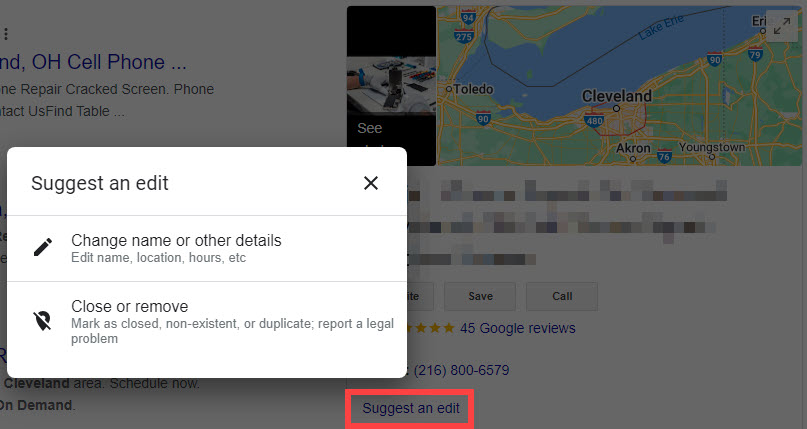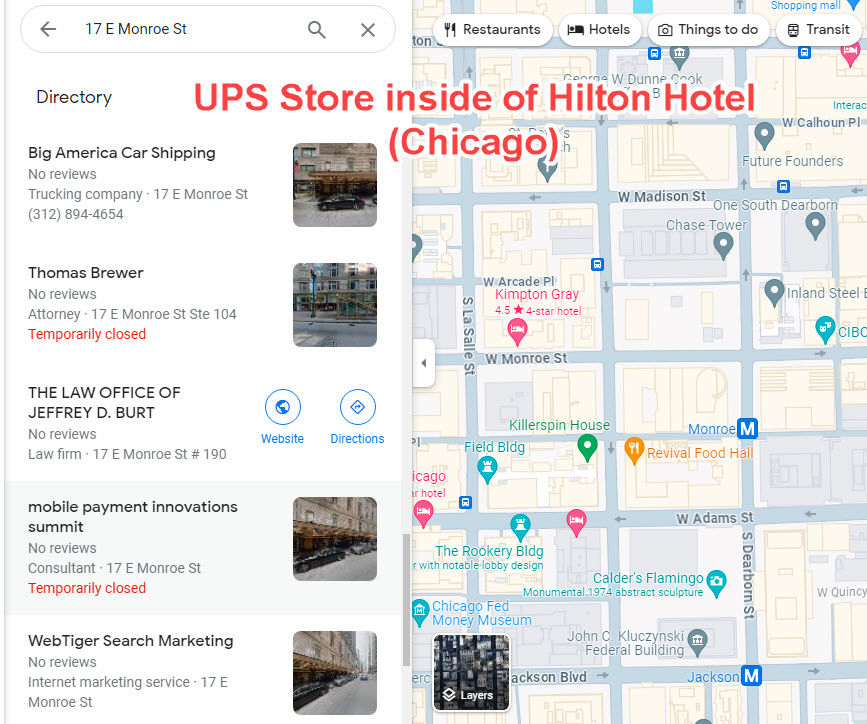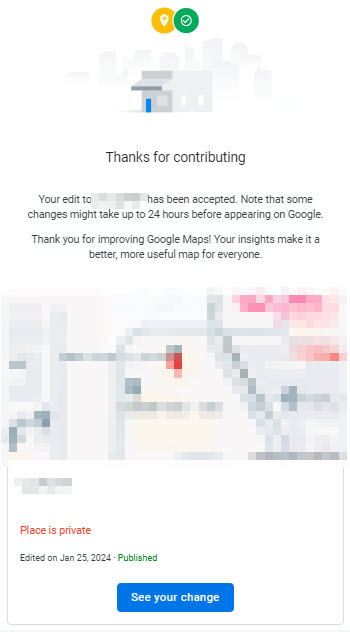When you use “suggest an edit” to report a business that’s spamming Google Maps, your standard operating procedure might go something like this: you send in only one report per Google Business Profile per violation, and you wait until Google approves or rejects it before you do anything else. That’s not bad SOP, and often it’s good enough.
But impatience can be a virtue – at least if you measure success by how many of your Google Maps anti-spam reports get approved, or by how quickly they’re approved. Some forms of repetition Google ignores. Other kinds of repetition seem to make Google’s ears perk up.

Google Maps spam-mitigation is one small part of the work I do for clients, but it’s an important part (as I’ve described many times). In my efforts to thin the herd, I’ve noticed two things that seem to happen more frequently than they used to:
1. I’ll report a problem (typically a bogus GBP page or address), and after the edit has been pending for a few days or a couple of weeks, I’ll re-report the same issue and sometimes it will be approved the second time around. Same business, same edit, same person reporting it.
2. I’ll report a GBP page that should not exist, and if the edit has been rejected or hasn’t been approved quickly (within a few hours or maybe a couple of days), I’ll do a second report, but this time provide a different reason for requesting removal. In many cases, your second edit may prompt Google to approve the first edit, or Google may just approve the second edit. 6 of one, half a dozen of the other.
What’s surprising to me is not that Google accepts, rejects, or delays acting on an edit, but rather how easily you can get Google to reconsider. Not always, but often, you can turn a no or a maybe into a yes. (Of course, I’m assuming you have a solid basis to propose the edit you’re proposing).
In my experience, having other people report a Google Maps party foul can increase the likelihood of an approval, and the same is true of filling out the redressal form. Either or both of those steps should be part of your anti-spam routine if competitors’ Maps spam is a big problem in your market. So I suggest you also add a second pass to your routine (more on that in a minute).
You and I would agree that all of this is a hassle. It’s a shame you need to spend any time on this stuff in the first place, let alone that you may need to take second passes at competitors’ spam. The hard reality is that Google crowdsources its quality-control. If you don’t report a problem on someone’s GBP page, Google is unlikely to know about it, or even to consider it a problem. The corollary is that if you report a problem, rather than 3 distinct problems, Google will assume there’s only one problem and that everything else checks out. Only the problem you report seems to get noticed. I think that’s part of what is going on here. It’s a very literal reaction on Google’s part, kind of like if you ask someone “Can you tell me what time it is?” and that person replies “Yes.”
So what do I suggest you do? In addition to patrolling Maps in the way I suggest, consider 3 new SOPs:
1. Do a “suggest an edit” on each distinct problem you see on a competitor’s GBP page. If it’s an extraneous GBP page, report it as “Offensive, harmful, or misleading.” If that page also uses a home address, report it as “Not open to the public.” If the name has stuffed-in keywords, submit whatever the real name of the business is. Google won’t ignore the one edit just because you sent in others. On the contrary, Google is more likely to agree with you on something if you’ve told it about every problem you see.

2. When you’re reporting a GBP page that Google should remove, try proposing different reasons for removal. If “Offensive, harmful, or misleading” didn’t dislodge a fake-address page, try “Not open to the public” or whatever other problem is roughly applicable.

3. Try again, or try something else, if the edit is “pending” for a long time. In other words, don’t mistake a pending edit for a rejection. If you reported a problem a month ago, and you know you’re in the right, try it again. If possible, have someone else follow suit. There is a solid chance it will work.

Will those additional steps work every time? No. Not even close. But they might spur Google to do the proper thing 20% of the time rather than 10% of the time. Sometimes the difference between lying in the mud and getting found by customers in the Google Maps 3-pack is one lousy competitor who’s outranking you just because of skulduggery. You may be able to pick off that one competitor, to start with.

What works for me: After researching local listings to see who’s who, I build a worksheet.
I’ll go over the list of competitors with my client. They know the area better than I do. They know who exists and who doesn’t.
• I’ll have a client visit places which don’t exist, snap pictures of the storefront, coat closet, whatever – then I report to G with images = “Doesn’t Exist Here”
• I’ll check biz names via dept of Insurance, state gov sites for DBA, etc – if it doesn’t exist I change the name that is actually on the license, or DBA or if it truly doesnt exist (lead gen sites) it it goes away.
• Always a good idea to keep a worksheet which includes biz name, address, phone, website, link to G local, reason for edit, date of when edit suggested (sometimes in multiple columns)
Those are excellent SOPs, Nick. Very similar to what I do, although you go the extra mile in a couple of ways.
Given how thorough your process is, adding the once-over to your list will probably help you pick off a few more spam blobs.
It depends on the market and vertical, but here in Toronto, it can be pretty heavy in the usual spots like Garage Doors, Locksmiths Roofing, etc. My reporting generally gets good results and in many cases in minutes. Sometimes, we do multiple and from the same email as well. I’ve seen responses I forgot I reported coming months later. Appreciate the topic, nice tips and a solid reminder of these other things some of us do for our clients.
That sounds about right, Jeff. It’s nice when Google agrees with one of your edits right out of the chute.
Are they algo auto approvals in some cases ? Obviously these aren’t all human approvals? Like do we build credibility overtime etc ?
That’s a great question. I don’t know for sure, but my working understanding always has been: the instant and super-fast approvals are algorithmic, whereas the slow-cooker approvals (or or rejections) may involve a human.
In any event, you do build credibility over time. Not that Google will approve an edit of mine that it isn’t already in agreement with, but more in that Google is more likely to make a decision on a problem I bring up, rather than just ignore it.
This is an OLD post, but it still conveys the basic situation pretty well: https://www.localvisibilitysystem.com/2013/01/28/google-mapmaker-101-for-local-business-owners/
Hey Phil
What frustrates us no end – in Australia in our case – is the fact that now you cannot move an address or create a new GBP without submitting a video to Google of the new location/business, complete with walking in, unlocking front door, showing signage etc.. Given the high bar, I am continually flummoxed by these GBP’s that are clearly fake! How the hell did these listings get created/approved given we have to do produce a mini ‘Gone with the wind’?
G’day, Phillip,
I hear you. The Maps spam situation is particularly bad in Australia, for whatever reason(s), at least in my experience.
Most spammy GBP pages you’ll see are up because (1) they predate Google’s broad use of video verification (it’s been a less-used option for years) and have been grandfathered in, and because (2) nobody has sent up the appropriate smoke signal. Google’s general MO is that there are no problems where there are no complaints.
If you get some of those spammy pages suspended now, with video as Google’s current preferred verification method, probably a lot of them will be unable to re-verify easily or at all.
Great suggestions Phil. As usual, you highlight doing the dirty work to get results, and I’m reminded how persistence may pay off.
So, I’m going to try putting this back on my To-do list. I’d dialed it way back since it’s been less and less effective, and even some prominent SEO guys said they gave up on spam fighting. Thanks for the inspiration!
Thanks, Tony. Yeah, I’m not sure what those people are seeing or thinking. Spam-fighting is as effective (and frustrating) as ever. If there was a ever a time that it seemed to be tougher sledding than usual, I’d say that was maybe a year-and-a-half ago.
I think one rock some people have crashed into is that probably a greater % of spam are the hard cases – the stubborn spam. Either GMB pages that have been reported a million times and that Google thinks (correctly or not) are legit and should stick around, or GMB pages in the hands of very nimble, clever spammers. In other words, there may be less low-hanging fruit now, at least in those SEOs’ clients’ markets, and they got too used to the low-hanging fruit.
Anyway, even though Google still won’t approve nearly every good edit, your doing a once-over will usually help you pick off a couple more. Persistence FTW.